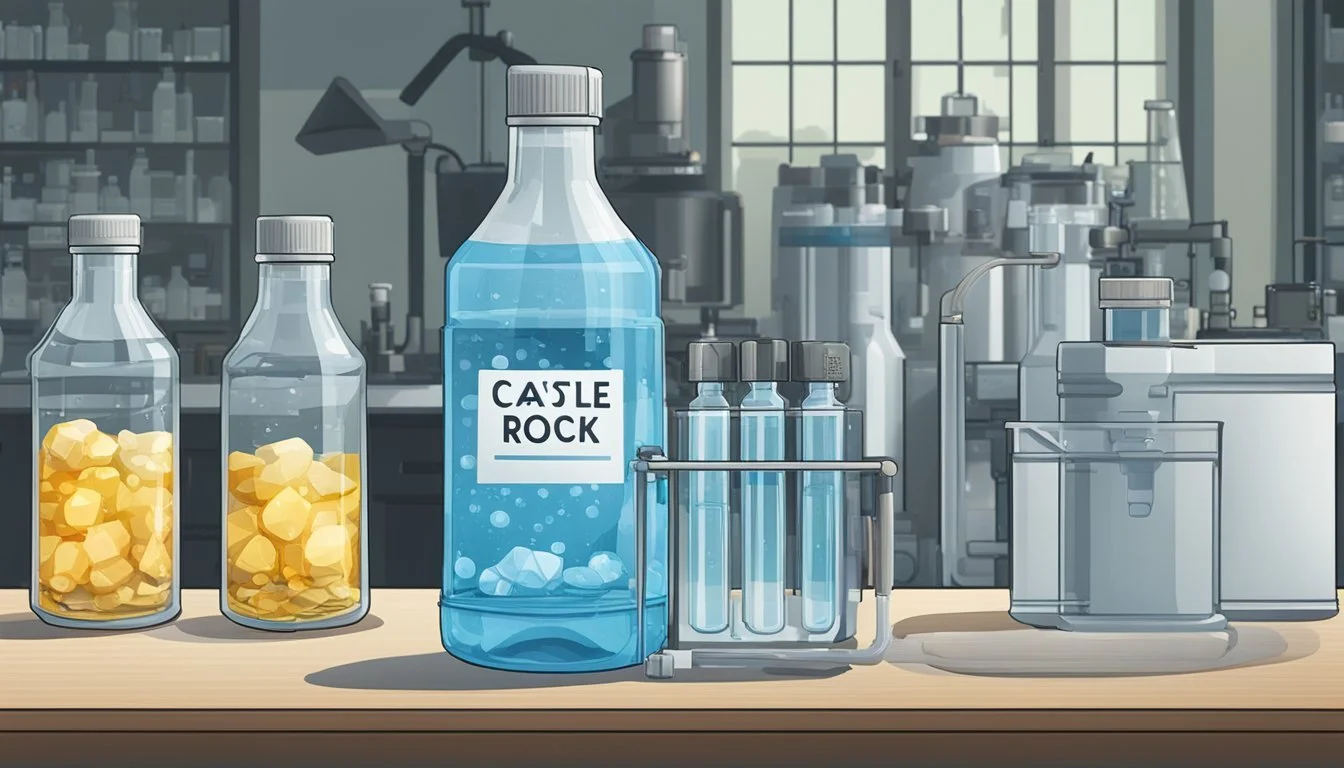Castle Rock vs. Big Win
Comparing Quality and Taste
Choosing between Castle Rock and Big Win bottled water can be quite a task for the discerning consumer. Castle Rock, known for its crisp flavor reminiscent of a morning hike in the mountains, takes pride in its natural purification cycle from glacier to spring. Sourced from Shasta Spring, this water offers a refreshing and pure taste that many find invigorating.
Big Win, on the other hand, is a purified water brand that stands out for its reliability and clean taste. It comes from Rite Aid, making it a readily available option for many. Despite its accessibility, it doesn't compromise on quality, which is crucial for everyday hydration needs.
For those seeking a more natural and refreshing option, Castle Rock seems to be the superior choice. Its environmentally friendly packaging and commitment to quality resonate with consumers who prioritize health and sustainability. However, Big Win remains a strong contender for those who value consistency and affordability in their bottled water.
The Essence of Bottled Water
Understanding bottled water involves knowing its source, the bottling process, and the different types of water available on the market.
Origin and Source
The origin and source of bottled water define its quality and taste. Natural spring water is sourced from underground springs, providing a fresh, crisp flavor directly from nature. Artesian water is obtained from a confined aquifer, which adds to its unique mineral content and taste.
Mineral water is rich in essential minerals and must come from natural sources, retaining its natural properties. Purified water, on the other hand, can come from any source but goes through extensive purification processes to remove contaminants, often resulting in a more neutral taste.
Bottling Process
The bottling process is crucial in maintaining the purity and quality of the water. Natural spring and mineral waters are often bottled at the source, ensuring they retain their natural flavor and mineral content. In many cases, these waters undergo minimal filtration to maintain their pristine characteristics.
For purified waters, processes like reverse osmosis, distillation, and deionization are common. These methods remove impurities, resulting in a clean, pure product. Sparkling waters may be infused with carbon dioxide during bottling to add effervescence, enhancing their refreshing qualities.
The Different Types of Bottled Water
There are several types of bottled water, each catering to different preferences and needs. Natural spring water is known for its fresh taste and natural mineral content. Artesian water is favored for its unique taste profile due to the minerals from the aquifer.
Mineral water is valued for its health benefits due to its high mineral content. Purified water is ideal for those seeking a clean, neutral taste, free from contaminants. Sparkling water provides a bubbly alternative, perfect for those looking for a fizzy beverage option.
Each type offers distinct characteristics, making it essential for consumers to choose based on personal preference and health considerations.
Analyzing Water Quality and Safety
Castle Rock and Big Win bottled waters both undergo rigorous testing to ensure quality and safety. Understanding cleanliness, adherence to regulations, and potential contaminants is crucial for consumers.
Cleanliness and Purity Standards
Castle Rock water is sourced from pristine springs and undergoes natural filtration processes. The water is often treated with reverse osmosis and ultraviolet light to remove impurities and eliminate bacteria. This rigorous purification ensures the clean taste associated with Castle Rock.
Big Win water follows a slightly different purification route. This includes chlorination to disinfect and filtration to remove sediments and pollutants. Their facilities maintain high cleanliness standards to ensure the safety of the bottled water.
FDA Regulations and Compliance
Both brands must comply with the FDA's bottled water regulations which set standards for contaminants such as lead and bacteria. The FDA requires regular testing and strict reporting protocols to monitor these standards.
Castle Rock and Big Win must submit annual water quality reports that detail testing results and compliance status. These reports assure consumers that the water meets or exceeds safety standards, providing peace of mind.
Potential Contaminants
Despite stringent controls, both waters can still contain trace substances. Castle Rock focuses on preventing natural contaminants like sediments and organic matter through advanced filtration and ultraviolet light treatments.
Big Win, processed through chlorination, aims to tackle bacteria and chemical pollutants. However, they must be vigilant for contaminants like lead that can infiltrate water systems. Vigilant testing for pollutants ensures consumer safety.
The specifics of purification and compliance highlight the brands' commitment to delivering safe drinking water to consumers.
Taste Profiles of Castle Rock vs. Big Win
The taste profiles of Castle Rock and Big Win bottled water are distinct and cater to different preferences. This section will provide a detailed sensory analysis and discuss the role of minerality in the flavor of each water.
Sensory Analysis: Taste, Smell, and Mouthfeel
Castle Rock:
Castle Rock bottled water is known for its clean and crisp taste. On the palate, it presents a neutral flavor, making it less intrusive in taste tests. The smell of Castle Rock is minimal, which appeals to those who prefer a non-detectable aroma in their water. Its mouthfeel is smooth, offering a pleasant drinking experience with no aftertaste.
Big Win:
In contrast, Big Win purified water has a subtle taste but can be perceived as slightly flat by water sommeliers due to the reverse osmosis process. The smell is practically absent, ensuring no interference with the water’s taste. The mouthfeel of Big Win is consistent and soft, but some may notice a lack of distinct character compared to Castle Rock.
The Role of Minerality in Flavor
Castle Rock:
Castle Rock water contains natural minerals that play a crucial role in its flavor profile. These minerals contribute to its slightly alkaline taste, enhancing the overall drinking experience. The presence of minerals also impacts the water sommelier's scoring in taste tests, as they add depth and complexity to the flavor.
Big Win:
Big Win's purification process removes most of the minerals, resulting in a more neutral flavor. This lack of minerality can be a preference for those seeking a pure, unobtrusive water taste. However, it may lead to a perception of blandness among connoisseurs who appreciate the intricate flavors that minerals bring.
Comparison Table:
Aspect Castle Rock Big Win Taste Clean, neutral Subtle, slightly flat Smell Minimal Practically absent Mouthfeel Smooth, pleasant Soft, consistent Minerality Present, slightly alkaline Absent, neutral
Health and Hydration
Understanding how Castle Rock and Big Win bottled waters compare in terms of health benefits and hydration can help you make a more informed choice. This section explores the nutritional aspects and the hydration efficiency of both brands.
Nutritional Value of Bottled Water
Castle Rock is sourced from natural springs, ensuring the water is rich in essential minerals like calcium and magnesium. These minerals are beneficial for bone health and metabolic functions. Studies indicate that spring water, like Castle Rock, may have a slightly alkaline pH, which some believe can help neutralize acidity in the body.
Big Win bottled water, often sourced from municipal supplies, undergoes rigorous purification processes. While it may not have the same mineral content as spring water, it’s free from contaminants and additives. Both Castle Rock and Big Win avoid artificial sweeteners or preservatives, making them safe choices for everyday consumption.
Hydration and Health Benefits
Castle Rock water's natural mineral content can aid electrolyte balance, which is crucial for post-exercise recovery and maintaining energy levels. Its slight alkalinity may also be beneficial for those looking to optimize their body’s pH balance. Naturally mineralized waters like Castle Rock can add value in terms of hydration efficiency due to their balanced composition.
Big Win water, while low in minerals, ensures reliable hydration without the potential taste impact of higher mineral content. It’s a versatile option for all-day hydration. Both brands fulfill the primary function of drinking water: keeping the body hydrated, supporting kidney function, and maintaining skin health.
Conclusively, both Castle Rock and Big Win have unique advantages in their approach to hydration and health, catering to varied preferences based on mineral content and alkalinity.
Brand Analysis: Castle Rock and Big Win
Castle Rock and Big Win bottled waters have distinct histories and unique market positions, appealing to different consumer preferences based on their quality, branding, and availability.
History and Brand Philosophy
Castle Rock Water, founded by Thomas Greither, emphasizes purity and sustainability. The water is sourced from pristine springs and is known for its crisp flavor, reminiscent of a morning hike in the mountains. The brand’s philosophy centers around providing high-quality spring water while minimizing environmental impact through eco-friendly practices.
Big Win, a product of Rite Aid, focuses on affordability and accessibility. Marketed as purified water, Big Win aims to cater to everyday hydration needs. The brand lacks a storied history but leverages its parent company’s extensive retail network to reach a broad customer base, emphasizing convenience and practicality.
Market Presence and Consumer Perception
Castle Rock Water positions itself as a premium brand in the bottled water market. It caters to health-conscious consumers who prioritize natural spring water and sustainable practices. Its market presence is strong among niche segments, though it may not be as widely available as some mainstream brands.
Big Win's market presence benefits from Rite Aid’s vast distribution channels, making it easily accessible to a wide demographic. Though it doesn’t claim premium status, it is favored for its cost-effectiveness and reliability. Consumer perception highlights its practical use for daily hydration without the premium price tag of specialty waters.
Environmental Impact and Sustainability
Castle Rock and Big Win bottled waters are assessed based on their eco-friendly packaging initiatives and water source conservation efforts. These key aspects highlight their commitment to reduced environmental impact.
Eco-Friendly Packaging Initiatives
Castle Rock emphasizes using 100% recycled PET (rPET) for their bottles. This approach significantly reduces plastic waste and lowers carbon emissions associated with producing new plastics. They also support community recycling programs, incentivizing customers to return bottles for reprocessing.
Big Win opts for lightweight plastic, which reduces material usage. They aim to introduce compostable bottle options by 2025. Additionally, their packaging incorporates biodegradable labels, decreasing the overall environmental footprint.
Water Source Conservation
Castle Rock sources water sustainably from natural springs in protected areas. They monitor water levels and quality to prevent over-extraction, working closely with local environmental agencies to ensure long-term viability.
Big Win employs modern extraction technologies that minimize disruption to local ecosystems. They invest in research to improve water use efficiency and continuously monitor environmental impact through partnerships with conservation organizations.
The Modern Consumer: Trends and Preferences
Consumers are increasingly prioritizing quality and sustainability in their bottled water choices. Market data reflects growing demand for premium waters and a shift towards eco-conscious purchasing decisions.
Rising Demand for Premium Waters
There is an evident trend towards premium bottled water. Americans are favoring brands like Aquafina, Dasani, and Glaceau Smartwater, underlining their preference for high-quality water. Data shows that the sales of bottled water, including premium varieties, have seen a significant rise. In 2020, the average American consumed 45.2 gallons of bottled water, reflecting a 3.5% increase from the previous year.
Premium water brands often emphasize their filtration processes, source purity, and unique mineral content. This appeals to health-conscious consumers who are willing to pay a higher price for perceived benefits. The marketing strategies of these brands highlight the purity and superior quality of their water, driving consumer interest and adoption.
The Shift Towards Eco-Conscious Purchasing
Environmental considerations are playing a crucial role in the purchasing decisions of modern consumers. Many are turning away from traditional bottled water brands due to concerns about plastic waste and its impact on the environment. Eco-conscious consumers favor brands that use recycled or biodegradable materials in their packaging.
Companies are responding by innovating with sustainable packaging solutions, such as recycled PET bottles and biodegradable options. Consumers are also more likely to support brands that champion environmental causes and commit to reducing their carbon footprint. This shift is not only influencing sales but also encouraging industry-wide changes towards more sustainable practices.
Comparing Accessibility and Availability
Castle Rock and Big Win, though both popular, differ significantly in their distribution and pricing structures. This comparison will help consumers understand where and at what cost they can find these two bottled water brands.
Retail Distribution Channels
Castle Rock is primarily found in health food stores and upscale grocery chains. These include places like Whole Foods Market and smaller organic grocers.
Big Win, associated with CVS Pharmacy, is more widely distributed across multiple retail outlets. It’s commonly available in large supermarket chains, convenience stores, and especially CVS locations, making it easily accessible to a broad audience.
Castle Rock consumers might have to seek out specialized stores, limiting spontaneous purchases. Big Win’s widespread distribution allows for easier and more frequent access.
Price Point Analysis
Castle Rock, marketed as a premium spring water, often comes at a higher price point. In health-centric stores, a single bottle can range from $1.50 to $2.50, depending on size and location. Bulk purchases can slightly reduce the cost per unit but still remain on the higher end.
Big Win, as a more mass-market brand, is positioned as an affordable option. Prices typically range from $0.50 to $1.00 per bottle in major supermarkets and CVS stores. Consumer-friendly pricing and frequent promotions make it a cost-effective choice for regular hydration needs.
Shoppers can expect Castle Rock to be an investment in premium quality, while Big Win offers budget-friendly pricing without compromising accessibility.
Conclusion: Toast to the Best Water
In deciding between Castle Rock and Big Win bottled waters, several factors come into play.
Castle Rock is recognized for its natural spring water originating from Mount Shasta, California. The water stands out for its smooth texture and clean taste. It's rich in minerals, offering a refreshing experience.
Big Win, often found in budget-friendly stores, provides a reliable and accessible choice. While it's not rated as high in flavor, it delivers in terms of affordability and availability.
Comparisons
Castle Rock:
Source: Mount Shasta, California
Taste: Smooth and clean
Minerals: Rich
Market Position: Premium
Big Win:
Source: Various locations
Taste: Basic
Affordability: High
Market Position: Economy
Bottom Line
When it comes to rankings, Castle Rock often scores higher for quality and taste. It's the best choice for those prioritizing a premium experience.
For those seeking value and convenience, Big Win serves as a practical option. While it may not top taste tests, it meets the basic hydration needs efficiently.
Taste, source, and cost should guide your decision in choosing between these brands. Whether savoring the richness of Castle Rock or opting for the practicality of Big Win, each has its distinct advantages.









